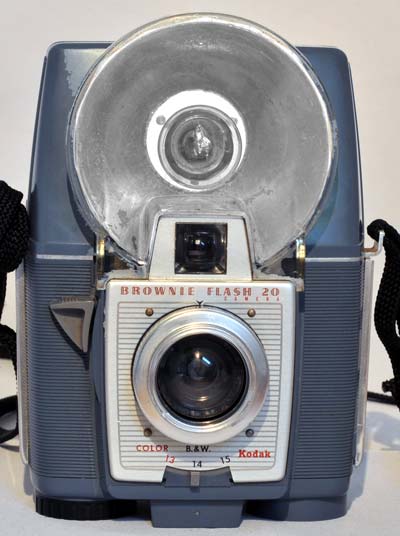Kodak Brownie Flash 20
Specification

| Manufacturer | : | Kodak |
|---|---|---|
| Produced | : | 1959 |
| Classification | : | Medium Format |
| Body Type | : | Solid Body |
| Construction | : | Plastic |
| Film Type | : | 620 |
| Film Width | : | 62mm |
| ImageSize | : | 2¼ x 2¼ in |
| No. of Images | : | 12 |
| Lens Type | : | uncoated meniscus |
| Focal Length | : | 70mm |
| Focus Type | : | variable |
| Focal Range | : | 4ft - inf. |
| Aperture Type | : | Multi hole |
| Aperture | : | f/11, f/16, f/22 |
| Shutter Type | : | Rotary |
| Shutter Speeds | : | I*(1/30sec) |
| Size (w x h x d) | : | 115 x 152 x 85 mm |
| Weight | : | 379g |
| * Measured on this camera | ||
Art Deco Credentials
![]()
Limited: Minor and insubstantial
- Designed after the main Art Deco period
- Wrap around horizontal ribbing on the Bakelite body
- Lined pattern on camera face
- Aluminium lens bezel
- Aluminium highlights on sides
- Curved Streamline Moderne design
Description
This camera was introduced in April of 1959 and discontinued October of 1962. The camera was manufactured in the USA but was assembled in the UK from 1960 to 1961.
The Brownie Flash 20 has a blue/grey moulded plastic body. An unusual feature of this camera is that it has a large integrated flash unit. It has a reverse telescope type eye level viewer. The eye-level finder has a smaller square guide for use with slide film. A tripod mount is not provided.
The aperture control is labelled with the numbers 13,14 and 15. These are not F values but EV values based on the film ISO at the time. This was Verichrome Pan with an ISO of 80. My measurement reveal that EV13=f/11, EV14=f/16 and EV15=f/22. The shutter speed is 1/100s. The camera has front focussing and is labelled as Scenes (12ft-INF), Groups(6ft-12ft) and close-ups(4ft-6ft).
The film is loaded by moving a lever on the base so that the whole of the film transport system can be removed by lifting the top off the camera. It has an shutter interlocking system that avoids double exposure. When the film is loaded, the red window is used to locate the first frame. There is no need to use the red window again. The camera will move to the next frame and lock when the film is advanced by the wheel. The red window can't really be used to check how many frames have been taken because the auto advance and the annotation on the film get out of step. Not sure how you are supposed to know when 12 frames have been taken. The red window has a spring loaded sliding cover.
A small screw on the rear allows the battery compartment to be removed for the installation of a battery. It uses a 22.5v battery (EverReady B.155 or equivalent) which must be inserted base up. To use the flash, insert a small capless flashbulb into the centre of the dish. The used bulb is ejected using a spring push on the rear.
How to Use
See the User Manual for the Kodak Brownie Starflash, which is similar to this camera. . Note that the Starflash uses two smaller batteries rather than one in the flash unit.
This camera takes 620 film which is still available from selected photographic outlets. Although the actual film is the same as 120 film, the spools are different. The 620 spools are slightly shorter and have a smaller diameter. Do not use 120 film in this camera because it will jam and may snap. It is possible to cut down a spool of 120 film to fit or to re-spool some 120 film onto 620 spools in a darkroom or changing bag. See how to respool 120 to 620 here:- Respool 120 onto 620
If you don't want to bother with an exposure meter, follow the guide shown. It is based on the 'Sunny 16' rule. Film is so forgiving and will produce acceptable results even when overexposed by 2 or 3 stops or underexposed by 1 stop.
Remember that the exposure guide in the camera user manual may not be helpful as it is based on the use of old film with a low ISO value.
The table assumes that the sun is at least 30 degrees above the horizon - that's 10am - 5pm on a summer's day in the UK.
This camera has 3 aperture settings of EV13(f/11), EV14(f/16) and EV15(f/22) and a shutter speed is 1/30s.
As the shutter speed is only 1/30s, it is advisable to try to hold the camera against a wall or other solid object. For quick snapshots, hold it firmly against your face.
Using ISO 100/125 film - shutter speed 1/30s
| Weather Conditions | Shadow Detail | Aperture | Exposure |
|---|---|---|---|
 Sunny SunnySnow/Sand | Dark with sharp edges | EV15 | 2 Stops Overexposed Acceptable |
 Sunny Sunny | Distinct | EV15 | 1 Stop Overexposed Acceptable |
 Slight Overcast Slight Overcast | Soft around edges | EV15 | Good |
 Overcast Overcast | Barely visible | EV14 | Good |
 Heavy Overcast Heavy Overcast | None | EV13 | Good |
 Open Shade Open Shade/Sunset | None | EV13 | -1 Stop Underexposed Acceptable |